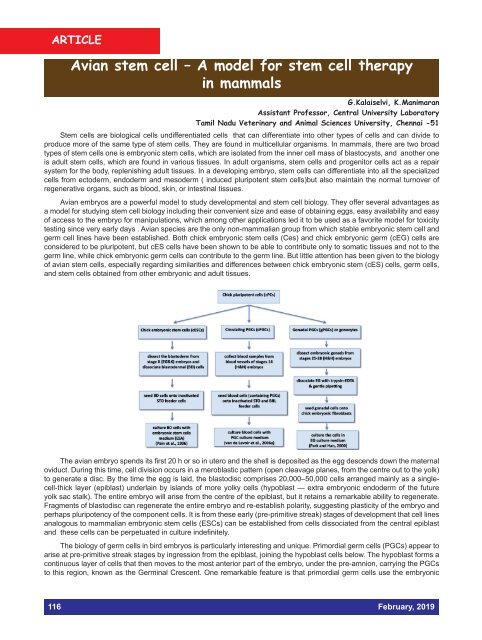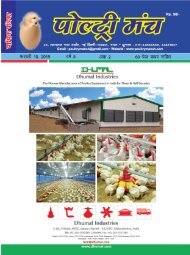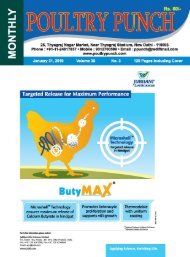POULTRY PUNCH - FEBRUARY 2019
POULTRY PUNCH - FEBRUARY 2019
POULTRY PUNCH - FEBRUARY 2019
- No tags were found...
You also want an ePaper? Increase the reach of your titles
YUMPU automatically turns print PDFs into web optimized ePapers that Google loves.
ARTICLE<br />
Avian stem cell – A model for stem cell therapy<br />
in mammals<br />
G.Kalaiselvi, K.Manimaran<br />
Assistant Professor, Central University Laboratory<br />
Tamil Nadu Veterinary and Animal Sciences University, Chennai -51<br />
Stem cells are biological cells undifferentiated cells that can differentiate into other types of cells and can divide to<br />
produce more of the same type of stem cells. They are found in multicellular organisms. In mammals, there are two broad<br />
types of stem cells one is embryonic stem cells, which are isolated from the inner cell mass of blastocysts, and another one<br />
is adult stem cells, which are found in various tissues. In adult organisms, stem cells and progenitor cells act as a repair<br />
system for the body, replenishing adult tissues. In a developing embryo, stem cells can differentiate into all the specialized<br />
cells from ectoderm, endoderm and mesoderm ( induced pluripotent stem cells)but also maintain the normal turnover of<br />
regenerative organs, such as blood, skin, or intestinal tissues.<br />
Avian embryos are a powerful model to study developmental and stem cell biology. They offer several advantages as<br />
a model for studying stem cell biology including their convenient size and ease of obtaining eggs, easy availability and easy<br />
of access to the embryo for manipulations, which among other applications led it to be used as a favorite model for toxicity<br />
testing since very early days . Avian species are the only non-mammalian group from which stable embryonic stem cell and<br />
germ cell lines have been established. Both chick embryonic stem cells (Ces) and chick embryonic germ (cEG) cells are<br />
considered to be pluripotent, but cES cells have been shown to be able to contribute only to somatic tissues and not to the<br />
germ line, while chick embryonic germ cells can contribute to the germ line. But little attention has been given to the biology<br />
of avian stem cells, especially regarding similarities and differences between chick embryonic stem (cES) cells, germ cells,<br />
and stem cells obtained from other embryonic and adult tissues.<br />
The avian embryo spends its first 20 h or so in utero and the shell is deposited as the egg descends down the maternal<br />
oviduct. During this time, cell division occurs in a meroblastic pattern (open cleavage planes, from the centre out to the yolk)<br />
to generate a disc. By the time the egg is laid, the blastodisc comprises 20,000–50,000 cells arranged mainly as a singlecell-thick<br />
layer (epiblast) underlain by islands of more yolky cells (hypoblast — extra embryonic endoderm of the future<br />
yolk sac stalk). The entire embryo will arise from the centre of the epiblast, but it retains a remarkable ability to regenerate.<br />
Fragments of blastodisc can regenerate the entire embryo and re-establish polarity, suggesting plasticity of the embryo and<br />
perhaps pluripotency of the component cells. It is from these early (pre-primitive streak) stages of development that cell lines<br />
analogous to mammalian embryonic stem cells (ESCs) can be established from cells dissociated from the central epiblast<br />
and these cells can be perpetuated in culture indefinitely.<br />
The biology of germ cells in bird embryos is particularly interesting and unique. Primordial germ cells (PGCs) appear to<br />
arise at pre-primitive streak stages by ingression from the epiblast, joining the hypoblast cells below. The hypoblast forms a<br />
continuous layer of cells that then moves to the most anterior part of the embryo, under the pre-amnion, carrying the PGCs<br />
to this region, known as the Germinal Crescent. One remarkable feature is that primordial germ cells use the embryonic<br />
116 February, <strong>2019</strong>






